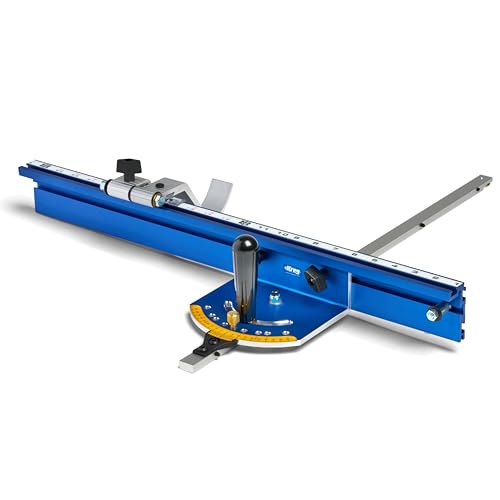If you’re looking to upgrade your table saw’s capabilities, you’ll want to take into account adding a quality miter jig to your workshop arsenal. These precision tools transform ordinary table saws into highly accurate cutting machines, capable of producing perfect angles every time. From the sturdy Rockler 45 Degree Sled to the micro-adjustable VEVOR gauge, today’s top miter jigs offer features that’ll take your woodworking projects to the next level.
Rockler 45 Degree Miter Sled for Table Saw
For woodworkers seeking precise 45-degree cuts, the Rockler Miter Sled delivers reliable performance at an affordable price point. You’ll find it particularly useful for picture frames and corner joints, with its user-friendly design requiring no initial adjustments for basic use.
The sled fits standard 3/8 x 3/4 miter slots and includes nylon set screws for a snug fit, though you’ll likely need occasional readjustments. Built-in clamping slots help secure your moldings at table level. While some users report fitment issues, you can improve performance with simple modifications like aluminum tape. Just be prepared to spend time fine-tuning the sled for ideal precision.
Best For: Hobbyist woodworkers and DIY enthusiasts who frequently make picture frames or need consistent 45-degree cuts for basic corner joints.
Pros:
- Simple, user-friendly design requires minimal setup for basic use
- Built-in clamping slots help secure workpieces effectively
- Affordable solution for making consistent 45-degree cuts
Cons:
- Requires frequent readjustment of set screws to maintain accuracy
- Initial fit may be loose and need modifications for optimal performance
- Lacks detailed instructions for setup and adjustment
WEN Premium Miter Gauge for Table Saws (WA1401)
Woodworkers seeking premium accuracy and durability will find the WEN Premium Miter Gauge (WA1401) an exceptional upgrade for their table saws. Built with heavy-duty steel and brass, this gauge features 27 precision-cut angle stops from 0 to 60 degrees, including the essential 22.5-degree setting.
You’ll appreciate the user-friendly design with laser-etched markings and oversized brass handles for better control. The smooth-gliding phenolic bottom guarantees consistent performance, while the T-track disc makes it compatible with both U-shaped and T-shaped miter slots. It’s universally designed to fit standard 3/4-inch by 3/8-inch slots, and you’re backed by a two-year warranty.
Best For: Woodworkers and DIY enthusiasts who need precise angle cuts and want a durable, premium-quality miter gauge for their table saw, router table, or band saw.
Pros:
- Heavy-duty steel and brass construction ensures long-lasting durability
- 27 precision-cut angle stops with micro-adjustment capability for accurate cuts
- Universal design fits standard miter slots with smooth-gliding phenolic bottom
Cons:
- Higher price point compared to basic miter gauges
- Relatively heavy at 3.52 pounds, which may affect handling
- Available only since March 2024, so long-term reliability is yet to be proven
VEVOR Precision Miter Gauge with Adjustable Angle Stops
Professionals seeking precision in their table saw work will appreciate the VEVOR Precision Miter Gauge‘s impressive range of 15 positive angle stops. You’ll find stops at common angles like 90°, 45°, and 22.5°, plus their negative counterparts for versatile cutting options.
The aluminum alloy construction keeps this 3.6-pound gauge lightweight yet durable, while the spring-loaded plunger eliminates unwanted movement in your saw’s slot. You’ll get micro-adjustment capability through the convex-concave grating system, and the laser-etched angle plate guarantees lasting accuracy. If you’re looking to upgrade your stock miter gauge, this model’s 4.6-star rating from 291 users suggests it’s a reliable choice.
Best For: Professional woodworkers and serious DIYers seeking precision angle cuts who want to upgrade their standard table saw miter gauge with a more accurate and versatile option.
Pros:
- 15 positive angle stops provide precise, repeatable cuts at common angles
- Durable aluminum alloy construction with micro-adjustment capability
- Spring-loaded plunger eliminates unwanted movement in the saw slot
Cons:
- Some users report drag on table surfaces
- Higher price point compared to basic miter gauges
- May require additional UHMW tape for smoother sliding
Kreg Precision Miter Gauge System (KMS7102)
The Kreg Precision Miter Gauge System stands out as a craftsman’s dream with its factory-calibrated accuracy and minimal setup requirements. You’ll appreciate its anodized aluminum fence and high-speed steel blade that deliver precise crosscuts and angled cuts.
The system’s brass pin enables quick angle adjustments with five positive stops, while the vernier scale lets you fine-tune to 1/10 degree. You’ll find the patented Swing Stop particularly useful for repeatable cuts, and the five bar adjusters guarantee smooth operation. While some users note concerns about part durability, the 4.4-star rating from 959 reviews confirms its reliability for most woodworking projects.
Best For: Woodworking enthusiasts and professionals seeking high-precision miter cuts with repeatable accuracy for furniture making, trim work, and detailed carpentry projects.
Pros:
- Exceptional accuracy with vernier scale allowing fine adjustments to 1/10 degree
- Factory calibrated with minimal setup required and five positive stops for common angles
- Sturdy anodized aluminum construction with convenient Swing Stop for repeated cuts
Cons:
- Higher price point compared to standard miter gauges
- Some components may require additional fitting depending on saw table
- Concerns about long-term durability of certain parts
Factors to Consider When Choosing a Miter Jig for Table Saw
When you’re shopping for a miter jig for your table saw, you’ll need to evaluate several critical features to guarantee you get the right tool for your needs. The most important factors include the precision of angle adjustments and control mechanisms, the durability of materials and construction quality, how well the gauge fits your saw’s miter slot, and how easily you can make adjustments. You’ll also want to take into account the fence length and support capacity, as these directly impact your ability to handle larger workpieces safely and accurately.
Precision and Angle Control
Achieving perfect miter cuts demands exceptional precision and angle control from your table saw jig. You’ll want to look for models with multiple preset angle stops, which allow for consistent cuts from 0 to 60 degrees. High-quality miter gauges feature micro-adjustment mechanisms or expansion discs for fine-tuning your angles with minimal deviation.
Pay attention to the gauge’s construction and readability. Laser-etched markings provide clear measurements that’ll help you avoid setup errors, while heavy-duty steel or aluminum construction guarantees long-term stability without warping. Don’t overlook the importance of a secure fit in your saw’s miter slot – any play or looseness will compromise your cuts. Choose a jig that offers adjustability to eliminate gaps and maintain a snug fit throughout its service life.
Material and Build Quality
Material selection stands at the forefront of every quality miter jig, with aluminum alloy and heavy-duty steel leading the pack for durability and precision. You’ll find these materials offer superior resistance to deformation, ensuring your cuts remain accurate over time.
When examining build quality, look for features that enhance performance, such as low-friction surfaces or phenolic bottoms. These components help your jig glide smoothly across the table saw, resulting in cleaner, more precise cuts. You’ll also want to evaluate the jig’s weight – heavier models provide stability during operation, while lighter ones offer easier handling and adjustments. Pay attention to models that include micro-adjustment capabilities, as they’ll allow you to fine-tune angles with greater precision, ultimately improving your woodworking results.
Slot Fit and Compatibility
A proper fit between your miter jig and table saw slot serves as the foundation for accurate cuts. You’ll want to guarantee your chosen jig matches the standard 3/4″ x 3/8″ miter slot dimensions found on most table saws.
Look for jigs that work with both T-shaped and U-shaped slots, as this versatility allows you to use the tool across different saw brands. Many quality jigs offer micro-adjustment features to achieve a perfect fit in your miter track. It’s essential to check if the gauge includes a mechanism to eliminate any unwanted play or movement within the slot.
Before making your final decision, review user experiences with specific models, as they’ll often highlight real-world fit issues and necessary adjustments that might affect your workflow.
Adjustment and Setup Ease
When choosing a miter jig, the setup process plays an essential role in your overall woodworking experience. You’ll want to look for models that come with clear instructions to avoid frustration during initial installation. While some jigs may fit loosely at first, they should allow for necessary adjustments to achieve optimal functionality.
Consider jigs equipped with nylon set screws or micro-adjustment features, as these will help you fine-tune your cuts with precision. However, remember that these mechanisms might need periodic tweaking to maintain accuracy. The presence of positive stops at common angles will save you time during setup and help streamline your workflow. Before making your final decision, verify that your chosen jig aligns properly with your table saw’s miter slots to prevent compatibility issues that could hinder both setup and operation.
Fence Length and Support
Fence length stands as an essential factor in determining your miter jig‘s overall performance and versatility. You’ll want to verify the fence is long enough to support your typical workpieces, as longer fences provide better stability and control during cuts, especially when working with wider materials.
Look for a miter jig with adjustable fence capabilities, as this feature will let you accommodate different material sizes and tackle more complex projects. The fence should remain perfectly rigid without any wobble or flex, keeping your workpiece flush against the surface. Don’t forget to take into account additional support options like built-in clamps or the ability to attach auxiliary supports. These features will help you maintain precise angle cuts and verify your materials stay securely positioned throughout the cutting process.
Safety Features Available
Since your safety should always be the top priority in woodworking, choosing a miter jig with robust safety features is vital for table saw operations. You’ll want to look for models with adjustable clamps that firmly secure your workpiece, preventing any unwanted movement during cuts. A built-in stop mechanism will guarantee precise measurements while protecting you from accidental overcuts.
Consider jigs with sliding mechanisms that keep your hands safely away from the blade throughout operation. A wide, stable base is essential as it prevents tipping and maintains stability during use. If you’re concerned about visibility and workspace cleanliness, opt for a model with an integrated dust collection system. These features won’t just protect you – they’ll also help you achieve better, more consistent results in your woodworking projects.






